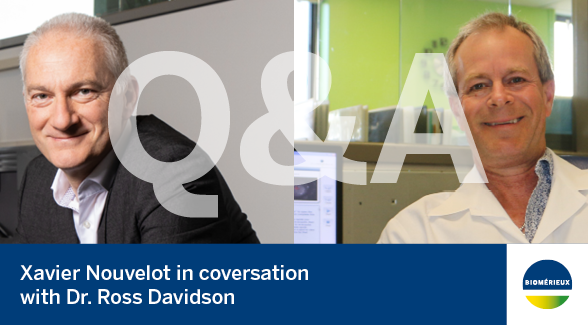
In conversation with Xavier Nouvelot, this article is part of an ongoing series in which bioMérieux Canada’s General Manager connects with key industry experts and healthcare innovation partners on topics that matter most in the rapid diagnostics and health informatics fields.
How are rapid diagnostic solutions supporting sepsis diagnosis and treatment in Canada? bioMérieux Canada’s Xavier Nouvelot speaks to Dr. Ross Davidson, Director of Bacteriology at Halifax’s Queen Elizabeth II Health Sciences Centre about the importance of rapid diagnostics in diagnosing sepsis. Dr. Davidson speaks to how crucial a test’s speed and ease of use are in a lab setting, how diagnostics support antimicrobial stewardship and how bioMérieux’s FilmArray BCID Panel can positively impact patient outcomes.
XN: What technological advances have taken place in the past 5 to 10 years that have changed how you manage diagnosis in sepsis patients?
RD: In a microbiology lab, it boils down to how fast you can identify a bacterial pathogen and how quickly you can test for antibiotic susceptibility. Fifteen years ago, we were using biochemical tests to identify bacteria. While some were automated to a certain degree, they were nevertheless slow. In the past five years, instruments such as bioMérieux’s FilmArray BCID Panel have revolutionized microbiology because they utilize molecular methods that are exceedingly rapid, accurate and easy to use.

XN: How is AMR affecting your ability to treat patients with sepsis?
RD: Virtually every hospital worldwide has to deal with methicillin-resistant Staphylococcus. One of the significant advantages of the FilmArray BCID Panel is its ability to determine, within an hour, if the patient has Staphylococcus and if it is methicillin resistant. As a result, it allowed us to treat many patients with antimicrobials that are more effective, less expensive and less toxic.
XN: When assessing diagnostic solutions available on the market, what capabilities do you look for?
RD: Let’s say we are looking to bring a diagnostic test into our lab. It has to be sensitive, relatively specific, and user-friendly, without having to go through additional supplementary testing. bioMérieux’s FilmArray BCID Panel can identify 95 percent of common bloodstream infections, so I know it will do the job that I want it to do.
One of the utilities that we were interested in with the BCID Panel was how it could benefit smaller communities. Community labs servicing these communities may be several hundred miles away from larger labs and often lack dedicated microbiologists, but they still need to treat bacteremic patients. bioMérieux’s FilmArray BCID Panel is a fantastic instrument in this setting. It allows technologists to identify pathogens present in a positive blood culture within an hour. Previously, this took several days, whether because of a lack of resources or the need to send the culture away to be tested for pathogens.
Additionally, most small community labs don’t have an antimicrobial stewardship (ASP) team. This rapid diagnostic solution’s speed allows physicians to make relatively strong empiric choices, even in the absence of a stewardship program.
XN: What were the key findings of the recent study you conducted featuring, among others, the bioMérieux’s FilmArray BCID Panel?
RD: Our study found several benefits of rapid diagnostic solutions like the FilmArray BCID Panel. One of the significant issues in labs is that whenever a new instrument is introduced, there can be several hours, even weeks of training. BCID is so simple; we trained multiple technologists within 30 minutes. Not a single person had a problem using BCID, making it very appealing for smaller labs and core labs where biochemistry technicians operate inside a 24-hour setting. Since you can generate results with BCID in one hour, this instrument is ideal for hospitals that have a 24/7 capability.
An exceptional example of the instrument’s sensitivity is the case of a single sepsis patient, where BCID identified nine different pathogens, and we were able to grow eight of the nine. I was impressed with the instrument’s ability to identify all those pathogens in a single blood culture.
XN: What were some standout instances during your study where the FilmArray BCID Panel positively impacted patient outcomes?
RD: Sepsis has a high mortality rate, which makes it a significant medical issue. So any way that we can improve patient outcomes certainly can be beneficial.
In our study, there were several instances where elderly patients who were not symptomatic were released from the emergency room before the BCID test results came back. In those situations, the BCID diagnosed them as having group A Streptococci in their bloodstream after being discharged. By calling them back immediately, we saved approximately 12 hours in getting the patient admitted to the hospital, which likely made a considerable difference in the patient’s outcome. Having the ability to identify bacteria very rapidly in a 24/7 lab can only benefit the patient.
XN: With your experience, what do you think is the future of diagnostic solutions for infectious diseases like sepsis?
RD: From a microbiology perspective, the identification of sepsis is crucial in saving lives. Using bioMérieux’s FilmArray BCID Panel, hospital labs can identify the bacterial pathogen associated with the patient’s sepsis 95 percent of the time, within an hour, which is a major advantage. In the future, I would like to see instruments that provide rapid susceptibility testing to match the identification speed. Depending on rates of resistance, having that susceptibility data upfront is going to be a major advantage.

Leave a Reply